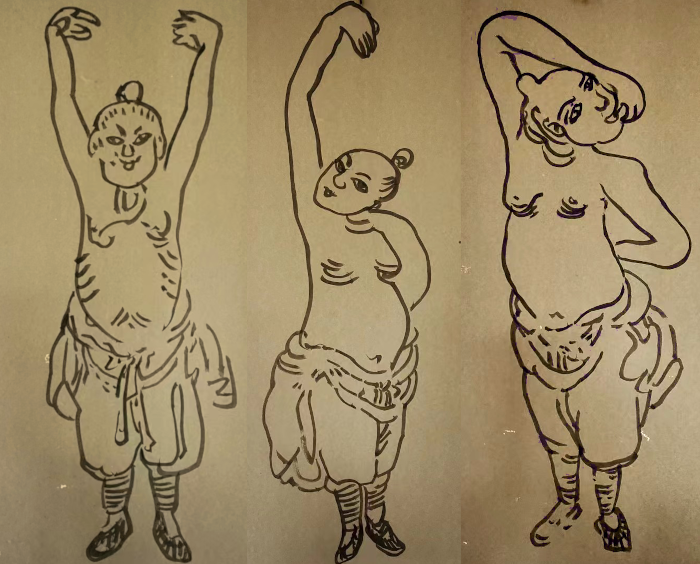
What is Yijinjing 易筋經?
Yijinjing 易筋经/易筋經 refers to a collection of methods of powerful Chinese neigong 内功 (“internal skill”). Legend has it that it originated from the Indian monk Bodhidharma (Damo 达摩) who came to China and founded Chan 禅 Buddhism (the form of Buddhism which later became known as Zen in Japan) at the Shaolin Temple. In fact, neigong containing the Yijinjing principles and signature movements can be found throughout China within various traditions.
The word Yijinjing consists of three Chinese characters:
Yi 易: The character’s two components are 日 “sun” and 勿 “not.” The sun represents constancy, it was the most constant thing in one’s visible surroundings. Putting the two characters together, we have “that which is not like the sun.” The opposite of constancy is change. Yi means to “change,” in this case, transform through practice.
Jin 筋: Jin refer to the connective tissues and basically all stringy tissues in the body, including tendons, ligaments, sinews, fascia, nervous tissue, etc. These tissues form a network throughout the body and hold everything together. “Jin” is often simply translated as “tendons” although anatomically we are actually referring to much more.
Jing 經: Jing is a complex word with many related meanings and can be translated as the meridian system, or as “classic” or “scripture.” Jing is also the warp of the “warp and woof” in weaving, that underlying framework that weavers weave first and string everything else through. Related to the meaning of “classic,” it can also refer to an underlying method, process, or tradition that has vitality and has endured the test of time.
Yijinjing practice can be thought of as the art of transforming the meridian system of the body and enhancing the flow of qi within it. One of the secrets to doing this, that the Chinese uncovered, was in recognizing the relationship between the meridian system of the body and the “Jin,” the body’s network of connective tissue. Just as qi and blood form a complementary yin-yang pair, so do the “tendon” system (connective tissues) and the meridian pathways of the body. Yijinjing: transforming the meridian system by way of the tendon system.
Of the Five Phases (water, wood, fire, earth, metal), the tendon system is represented by wood which relates to the spring season and the gallbladder organ system. The spring season represents the birth and upward trajectory of yang energy in nature’s cyclic rhythm. The Chinese discovered that focusing practice efforts here, on the tendon system, was the path to true inner strength, longevity, and vigorous health. As the saying goes, “for every inch of tendon we accrue ten years of life” (筋长一寸,寿长十年).
With regard to practice, there is also the saying “Externally train the tendons, bones, and skin, internally train a single breath of air” (外练筋骨皮,内练一口气). The most authentic and effective Yijinjing training systems will not just consist of a series of calisthenics that stretch the body. Rather, they will intelligently integrate various stretches and stimuli of the body’s tendon system along with appropriate coordination of the breath, mind and qi. This can form a holistic system of practice that follows the patterns of nature mapped out in Chinese classics such as the Yi Jing (易经) and the Huangdi Neijing (黄帝内经) and will lead to exceptional results.
It is these types of neigong that, in advanced practitioners, can lead to a state of development in which one has such an abundance qi and and such advanced levels of control over the energetics of their body that they are able to perform feats that many simply do not believe are possible. These include skills such as the powerful electric-like “wai qi” (外气) emission, the ability to break stones and bricks, impenetrable iron body skill, etc.
The most typical uses of these advanced skills are medical and martial, however, they can also be objective tests that a practitioner can use to gauge their progress and fuel their motivation for continued practice. A number of Buddhist and Daoist lineages also view this type of energetic cultivation as providing an ideal foundation that can best assist a practitioner, with more safety and stability, into practices that would be considered to be of a more spiritual nature, such as Daoist Neidan 内丹 and Buddhist Chan 禅 meditation, which often require the long and deep sessions of meditative stillness necessary to ultimately arrive at directly perceiving one’s “innate nature” (xing 性).

